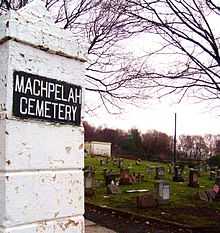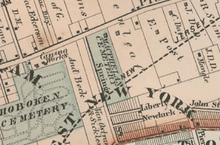Machpelah Cemetery, North Bergen
 Near the front entrance along Tonnelle Avenue | |
| Details | |
|---|---|
| Established | 1850 |
| Location | North Bergen, New Jersey |
| Country | USA |
| Size | 10 acres (40,000 m2) |
| Find a Grave | Machpelah Cemetery |
The Machpelah Cemetery, also spelled as "Macpelah Cemetery",[1][2] or "Macphelah Cemetery",[3] is a cemetery in Hudson County, New Jersey.[2]
Location

Machpelah Cemetery is located at 5810 Tonnelle Avenue, in North Bergen, New Jersey.[4] It is one of several burial sites along the western slope of the Hudson Palisades, which rise to the east 220 to 260 feet (67 to 79 m) above sea-level,[5] including the adjacent Hoboken Cemetery, and nearby Grove Church Cemetery, Weehawken Cemetery,[6] and Flower Hill Cemetery,[7] which together constitute a string of green open spaces in North Hudson County.[8] The entrance is just north of the Tonnelle Avenue terminus of the Hudson Bergen Light Rail.
History
Name
Machpelah is a name given to numerous cemeteries in the United States. The Cave of the Patriarchs or the Cave of Machpelah (Hebrew: מערת המכפלה, Me'arat HaMachpela, Trans. "Cave of the Double Tombs"; Arabic: المغارة Al Magharah, "the Cave") is a series of subterranean caves located in Hebron, Palestine.
Before the cemetery

Machpelah is contained within Lot No. 18 in then Maisland, which contained a celebrated and exotic garden, locally called the "Frenchman's Garden",[9] since the well-known botanist André Michaux was commissioned by the King of France, Louis XVI in 1786 as a botanist with the ability to import any plant, tree or vegetable from France that was desired by the United States. It also featured a variety of plants collected from the United States, as well as plants from all over the world.[9] It was enclosed in a stone wall, roughly 30 acres (120,000 m2) and kept by the gardener Pierre-Paul Saunier.[10] The Lombardy poplar was originally stocked in the garden, and, introduced into commerce, eventually spread throughout the United States.[11]
Use as a burial site
Located in the Bergenwood section of then New Durham,[1] land at Machpelah Cemetery was first used for burial purposes in 1850.[5] The cemetery was officially opened in 1853, by the Third Reformed Presbyterian Church Society of New York, and thus, was for many years strictly a Protestant cemetery.[12] It was considered to be a minor suburban burial ground for the New York Area during the 19th century,[13] as most of the surrounding vicinity of Hudson was sparsely occupied. Typical grave depths are approximately six feet, where roughly half of those dug reveal sand. Trap rock lies underneath most of the Palisades' ridge, and the soil has been described as being hard and compact, and thus difficult to dig through. Other sediments varying throughout the cemetery are yellowish earth, loose drift gravel, and pockets of sand.[5]
Overall, the grounds at Machpelah cemetery are approximately 10 acres (40,000 m2).[14] Because of the steep grade of the grounds and the eventual descent into the surrounding marshes in Secaucus, contamination of wells, springs, and water-courses in the surrounding area is very low.[5] It has offices that are on the cemetery grounds, and it had one at 108 West 25th street, New York City.[1] Although it has historically been a Protestant cemetery, it has buried other religious sects,[15] and has even been listed as a Jewish burial ground.[13] There are 9 American Civil War veterans graves at Machpelah Cemetery.[16]
A report from 1879 states that 2,500 graves lie in the cemetery, where the price of a grave annually was about $100,[5] and in the next century it was reported to have over 18,000 bodies in it.[12] Much of the grounds are now occupied.
In 1900, many who died in the massive fire on the Hoboken piers the SS Saale,[17] and SS Bremen on the North River (Hudson River) were interred at the cemetery and the adjacent Flower Hill in gravesites purchased by the shipping company.[18][19]
See also
References
- ↑ 1.0 1.1 1.2 Leonard, p. 51.
- ↑ 2.0 2.1 "Macphelah Cemetery". Placenames. Retrieved 21 September 2010.
- ↑ Rieser, p. 34.
- ↑ Inskeep, p. 229.
- ↑ 5.0 5.1 5.2 5.3 5.4 National Board of Health, p. 202
- ↑ National Board of Health, p. 201.
- ↑ "Hoboken Cemetery". Graveinfo. 2002–2010. Retrieved 21 September 2010.
- ↑ Hagstrom Map, Hudson County.
- ↑ 9.0 9.1 Winfield, p. 323.
- ↑ New York Botanical Garden, p. 106.
- ↑ Winfield, p. 324.
- ↑ 12.0 12.1 Leonard, p. 52.
- ↑ 13.0 13.1 Appleton, p. 155
- ↑ State Dept. of Health, p. 234.
- ↑ American Missionary Association, p. 200.
- ↑ "Machpelah Cemetery - North Bergen Cemetery". New Jersey Civil War Gravestones. 2003–2010. Retrieved 22 September 2010.
- ↑ "STONE QUAYS IS HOBOKEN; The North German Lloyd Company to Rebuild at Once. THE SAALE IS PUMPED DRY Tons of Decomposed Provisions Removed from Hold -- Search for Bodies Awaits Removal of Debris". The New York Times. 1900-07-14.
- ↑ "Ready to Raise the Saale Three More Bodies Found on the Burned Steamhip", The New York Times, July 11, 1900, retrieved 2011-08-31
- ↑ "NEW WAY TO GET A WIFE.; Barney Isaacs, Confronted with Mrs. Simons's Rejection, Moves, Her Furniture Into Another Flat". The New York Times. 1900-07-20.
Sources
- American Missionary Association (1881). "The American missionary". Congregational Home Missionary Society 35: 232. ISSN 1079-9044. OCLC 1480434.
- Appleton, D. (1902). "Appleton's dictionary of New York and vicinity". D. Appleton & Co V: 353. OCLC 604901070.
- Hagstrom Map (2008). Hudson County New Jersey Street Map. Hagstrom Map Company, Inc. ISBN 0-88097-763-9.
- Inskeep, Carolee (1998). "New York City Metropolitan Area Cemeteries". The graveyard shift: a family historian's guide to New York City cemeteries. Ancestry Publishing. p. 296. ISBN 0-916489-89-2.
- Leonard, J. H. (1901). The Leonard Manual of the Cemeteries of New York and Vicinity. BiblioBazaar, LLC. p. 148. ISBN 1-115-04459-1.
- National Board of Health (1879). "Cemeteries and Burials". Annual report of the National Board of Health, 1879-1885. Government Printing Office. p. 477.
- State Dept. of Health, New Jersey. Board of Health (1898). "Annual report". New Jersey. Board of Health: 392. OCLC 1759842.
- New York Botanical Garden (1957). "Garden Journal" 7–8. ISSN 0016-4585. OCLC 1570422.
- Rieser, Robert (1915). "Hudson County to-day: Hudson County, New Jersey; its history, people, trades, commerce, institutions and industries". Hudson Dispatch. p. 162. OCLC 35906879.
- Winfield, Charles Hardenburg (1874). "History of the county of Hudson, New Jersey: from its earliest settlement to the present time". Kennard & Hay Stationery M'fg and Print. Co. p. 568. OCLC 426912.
External links
- Aerial view of Hoboken, Machpelah, and Flower Hill at Graveinfo
- Find a Grave at Machpelah Cemetery
- Civil War Gravestones at Machpelah at New Jersey Civil War Gravestones
Coordinates: 40°47′17″N 74°01′31″W / 40.7881566°N 74.0251401°W